- Joined
- Oct 9, 2007
- Messages
- 47,583 (7.45/day)
- Location
- Dublin, Ireland
| System Name | RBMK-1000 |
|---|---|
| Processor | AMD Ryzen 7 5700G |
| Motherboard | ASUS ROG Strix B450-E Gaming |
| Cooling | DeepCool Gammax L240 V2 |
| Memory | 2x 8GB G.Skill Sniper X |
| Video Card(s) | Palit GeForce RTX 2080 SUPER GameRock |
| Storage | Western Digital Black NVMe 512GB |
| Display(s) | BenQ 1440p 60 Hz 27-inch |
| Case | Corsair Carbide 100R |
| Audio Device(s) | ASUS SupremeFX S1220A |
| Power Supply | Cooler Master MWE Gold 650W |
| Mouse | ASUS ROG Strix Impact |
| Keyboard | Gamdias Hermes E2 |
| Software | Windows 11 Pro |
AMD today launched its Ryzen 7040HS line of mobile processors targeting consumer notebooks of conventional thickness and portability, which AMD considers thin-and-light. This class of devices is positioned between ultraportable notebooks, and gaming notebooks or portable workstations. AMD already powers several segments of gaming notebooks and portable workstations with its Ryzen 7045HX series "Dragon Range" mobile processors, with CPU core counts ranging between 6 and 16; as well as the ultraportable segment with the Ryzen 7040U series; but while the 7045 series have their TDP rated in the 45 W to 65 W range, and the Ryzen 7040U in the 15 W to 28 W range, the company was lacking a current-generation processor lineup in the 35 W to 54 W segment, which the company is filling up with today's Ryzen 7040HS series launch.
The Ryzen 7040HS series processors are based on the 4 nm "Phoenix" monolithic silicon, just like the 7040U series, and is based on a combination of "Zen 4" microarchitecture for its CPU, RDNA3 graphics architecture for its iGPU, and the new XDNA architecture for its Ryzen AI on-chip accelerator. Physically, the "Phoenix" silicon features an 8-core/16-thread "Zen 4" CPU. Each core has 1 MB of dedicated L2 cache, and a 16 MB L3 cache is shared among the 8 cores. The iGPU features 12 RDNA3 compute units, which amount to 768 stream processors, along with 24 AI Accelerators (specific to the RDNA3 architecture); 24 Ray Accelerators, 48 TMUs, and 32 ROPs. The iGPU meets the full DirectX 12 Ultimate logo requirements. The Ryzen AI XDNA accelerator features 20 AI acceleration tiles, each with local memory.


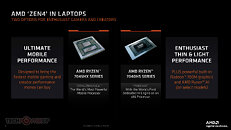
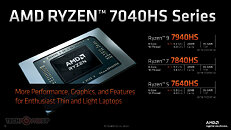
The I/O of "Phoenix" is similar to that of "Dragon Range," with support for dual-channel (4 sub-channel) DDR5, and LPDDR5, however its PCI-Express interface is Gen 4. The main PEG interface is PCI-Express 4.0 x16, and the CPU-attached M.2 NVMe slot is Gen 4 x4. Since the iGPU is based on RDNA3, the processor gets AMD's latest Radiance Display Engine, with hardware support for DisplayPort 2.1, and HDMI 2.1a. The iGPU also features the company's latest media acceleration capabilities, with a Dual Media Accelerator (two independent hardware accelerators that can each handle encode or decode, including support for the AV1 format). The Ryzen 7040HS series includes many of the power management innovations AMD introduced with its Ryzen 6000 "Rembrandt" mobile processors, and so even with a 35-54 W TDP class, notebooks based on the 7040HS series can offer up to 9 hours of video playback on a single charge (as measured on the Razer Blade 14 that's also launching today).
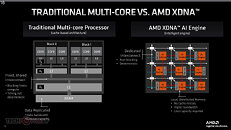

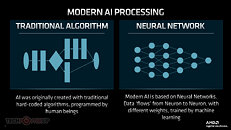

Ryzen AI is a hardware component that's separate from the CPU and iGPU, and is meant as an on-silicon AI accelerator, so software can perform many of the popular consumer AI-accelerated tasks, such as image manipulation, video conferencing enhancements, local media sorting, or even locally-based GPTs such as Office Co-pilot, removing the need for cloud-based AI services. For now, Microsoft is integrating Ryzen AI-accelerated features into Windows 11 and Office, but by the end of 2023, AMD expects a host of OEMs, ISVs, and big third-party software developers to be part of an ecosystem taking advantage of Ryzen AI. The accelerator supports ONNX and TensorFlow models right now, but by Q4-2023, AMD hopes to add PyTorch support. The company is also developing the AMD Unified AI Stack, which is a set of APIs that let software take advantage of not just the Ryzen AI accelerator, but also the AI-relevant ISA introduced with "Zen 4" (such as AVX-512, bfloat16, VNNI); and the AI Accelerators of the iGPU's RDNA3 compute units, for a "whole of silicon" approach to AI acceleration.

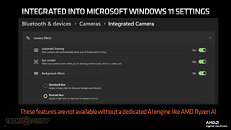

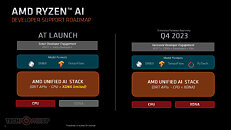
Designed by Xilinx, the XDNA architecture powers the Ryzen AI accelerator. This component is a network of AI Engine tiles (AIE tiles), each with a local memory, and a non-blocking, deterministic interconnect that connects it to neighboring tiles. There are 20 such tiles, and six memory levels to minimize round-trips to the DRAM memory. The AIE tile supports building and training of RNN, CNN, and LSTM AI networks. Among the datatypes supported are Int8, Int16, Int32, and bfloat16. Each AIE can be clock-gated to conserve power. The Ryzen AI accelerator supports up to 4 concurrent spatial streams (so 4 applications can be accelerated simultaneously, or an application can have a greater degree of parallelism). In terms of performance, AMD is claiming up to 10 AI TOP/s.
The Ryzen 7040HS lineup is rather slender, with just 3 processor SKUs—Ryzen 9 7940HS, Ryzen 7 7840HS, and the Ryzen 5 7640HS. The 7940HS tops the lineup, with an 8-core/16-thread CPU clocked at 4.00 GHz, with 5.20 GHz boost frequency, and the processor's full Radeon 780M iGPU with all 12 compute units enabled. The Ryzen 7 7840HS also packs an 8-core/16-thread CPU, but at slightly lower 3.80 GHz base frequency, and 5.10 GHz boost, along with the Radeon 780M iGPU, which has 8 compute units enabled. The Ryzen 5 7640HS gives you a 6-core/12-thread CPU clocked at 4.30 GHz base frequency, and 5.00 GHz boost; and the Radeon 760M iGPU. All three SKUs come with the Ryzen AI accelerator, and have their TDP configurable between 35 W and 54 W by the OEMs.
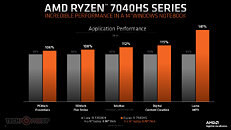
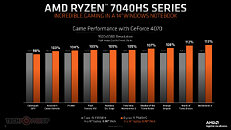

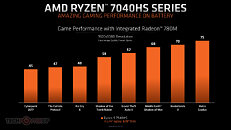
In terms of performance, AMD is claiming that the Ryzen 9 7940HS beats the Intel Core i9-13900H "Raptor Lake" by anywhere between 6% to 41% across application benchmarks that include PCMark Essentials, 3DMark FireStrike (CPU), 3dsMax, digital content creation, and LAME MP3 encoding. With a discrete GeForce RTX 4070 Laptop GPU, the 7940HS is shown being between -2% to 13% faster than the i9-13900H in gaming benchmarks. AMD is also claiming performance competitive to the Apple M2 Pro SoC powering the latest generation of MacBook Pro, with performance ranging between 1% to 11% in applications such as Blender, Cinebench R23, Photoshop, Cinebench R23 1T, and Passmark CPUmark. AMD also showed off the gaming capabilities of the Radeon 780M iGPU at 1080p resolution with low quality presets, with average framerates in the range of 45 FPS to 75 FPS.
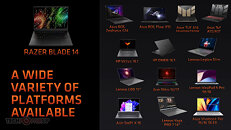
AMD is claiming dozens of design-wins for the Ryzen 7040HS series, spanning not just popular gaming notebook brands, but also some business notebook models. One of the highlights is the 2023 Razer Blade 14.
View at TechPowerUp Main Site
The Ryzen 7040HS series processors are based on the 4 nm "Phoenix" monolithic silicon, just like the 7040U series, and is based on a combination of "Zen 4" microarchitecture for its CPU, RDNA3 graphics architecture for its iGPU, and the new XDNA architecture for its Ryzen AI on-chip accelerator. Physically, the "Phoenix" silicon features an 8-core/16-thread "Zen 4" CPU. Each core has 1 MB of dedicated L2 cache, and a 16 MB L3 cache is shared among the 8 cores. The iGPU features 12 RDNA3 compute units, which amount to 768 stream processors, along with 24 AI Accelerators (specific to the RDNA3 architecture); 24 Ray Accelerators, 48 TMUs, and 32 ROPs. The iGPU meets the full DirectX 12 Ultimate logo requirements. The Ryzen AI XDNA accelerator features 20 AI acceleration tiles, each with local memory.




The I/O of "Phoenix" is similar to that of "Dragon Range," with support for dual-channel (4 sub-channel) DDR5, and LPDDR5, however its PCI-Express interface is Gen 4. The main PEG interface is PCI-Express 4.0 x16, and the CPU-attached M.2 NVMe slot is Gen 4 x4. Since the iGPU is based on RDNA3, the processor gets AMD's latest Radiance Display Engine, with hardware support for DisplayPort 2.1, and HDMI 2.1a. The iGPU also features the company's latest media acceleration capabilities, with a Dual Media Accelerator (two independent hardware accelerators that can each handle encode or decode, including support for the AV1 format). The Ryzen 7040HS series includes many of the power management innovations AMD introduced with its Ryzen 6000 "Rembrandt" mobile processors, and so even with a 35-54 W TDP class, notebooks based on the 7040HS series can offer up to 9 hours of video playback on a single charge (as measured on the Razer Blade 14 that's also launching today).




Ryzen AI is a hardware component that's separate from the CPU and iGPU, and is meant as an on-silicon AI accelerator, so software can perform many of the popular consumer AI-accelerated tasks, such as image manipulation, video conferencing enhancements, local media sorting, or even locally-based GPTs such as Office Co-pilot, removing the need for cloud-based AI services. For now, Microsoft is integrating Ryzen AI-accelerated features into Windows 11 and Office, but by the end of 2023, AMD expects a host of OEMs, ISVs, and big third-party software developers to be part of an ecosystem taking advantage of Ryzen AI. The accelerator supports ONNX and TensorFlow models right now, but by Q4-2023, AMD hopes to add PyTorch support. The company is also developing the AMD Unified AI Stack, which is a set of APIs that let software take advantage of not just the Ryzen AI accelerator, but also the AI-relevant ISA introduced with "Zen 4" (such as AVX-512, bfloat16, VNNI); and the AI Accelerators of the iGPU's RDNA3 compute units, for a "whole of silicon" approach to AI acceleration.




Designed by Xilinx, the XDNA architecture powers the Ryzen AI accelerator. This component is a network of AI Engine tiles (AIE tiles), each with a local memory, and a non-blocking, deterministic interconnect that connects it to neighboring tiles. There are 20 such tiles, and six memory levels to minimize round-trips to the DRAM memory. The AIE tile supports building and training of RNN, CNN, and LSTM AI networks. Among the datatypes supported are Int8, Int16, Int32, and bfloat16. Each AIE can be clock-gated to conserve power. The Ryzen AI accelerator supports up to 4 concurrent spatial streams (so 4 applications can be accelerated simultaneously, or an application can have a greater degree of parallelism). In terms of performance, AMD is claiming up to 10 AI TOP/s.
The Ryzen 7040HS lineup is rather slender, with just 3 processor SKUs—Ryzen 9 7940HS, Ryzen 7 7840HS, and the Ryzen 5 7640HS. The 7940HS tops the lineup, with an 8-core/16-thread CPU clocked at 4.00 GHz, with 5.20 GHz boost frequency, and the processor's full Radeon 780M iGPU with all 12 compute units enabled. The Ryzen 7 7840HS also packs an 8-core/16-thread CPU, but at slightly lower 3.80 GHz base frequency, and 5.10 GHz boost, along with the Radeon 780M iGPU, which has 8 compute units enabled. The Ryzen 5 7640HS gives you a 6-core/12-thread CPU clocked at 4.30 GHz base frequency, and 5.00 GHz boost; and the Radeon 760M iGPU. All three SKUs come with the Ryzen AI accelerator, and have their TDP configurable between 35 W and 54 W by the OEMs.




In terms of performance, AMD is claiming that the Ryzen 9 7940HS beats the Intel Core i9-13900H "Raptor Lake" by anywhere between 6% to 41% across application benchmarks that include PCMark Essentials, 3DMark FireStrike (CPU), 3dsMax, digital content creation, and LAME MP3 encoding. With a discrete GeForce RTX 4070 Laptop GPU, the 7940HS is shown being between -2% to 13% faster than the i9-13900H in gaming benchmarks. AMD is also claiming performance competitive to the Apple M2 Pro SoC powering the latest generation of MacBook Pro, with performance ranging between 1% to 11% in applications such as Blender, Cinebench R23, Photoshop, Cinebench R23 1T, and Passmark CPUmark. AMD also showed off the gaming capabilities of the Radeon 780M iGPU at 1080p resolution with low quality presets, with average framerates in the range of 45 FPS to 75 FPS.

AMD is claiming dozens of design-wins for the Ryzen 7040HS series, spanning not just popular gaming notebook brands, but also some business notebook models. One of the highlights is the 2023 Razer Blade 14.
View at TechPowerUp Main Site



